How to Read a Measuring Tape Cm
A measuring tape is 1 of the near useful sewing tools and indispensable in whatsoever sewing room. Today, a tape measure on the tailor's neck is the aforementioned iconic professional attribute as a doctor's stethoscope. This tape measure guide will focus on the following topics:
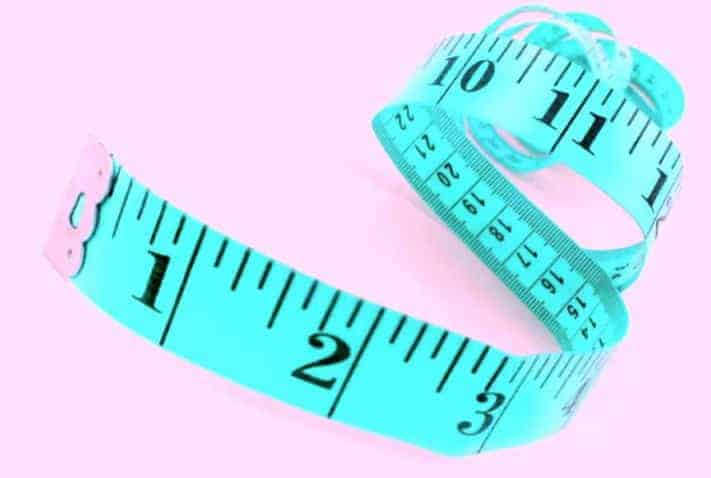
1. What is a tape measure for sewing?
The tape mensurate for sewing is usually soft and flexible strip/ribbon with linear-measurement markings made by and large from reinforced polyester or fiberglass. The about common length of a measuring record is sixty inches ( or 152 cm), just there are tapes for sale, for example, 100 inches long (254 cm) or fifty-fifty longer 120" (304 cm) which tin be useful for measuring longer lengths (like curtains, quilts and other abode decor items).
2. Uses of a tape measure in sewing
A record measure is used primarily for taking torso measurements, as well equally for drafting patterns, measuring fabric, laying out patterns on fabric, specifying the length of a garment, checking the size of hems, measuring curves and corners, measuring curtains, quilts … and much more. Information technology's but necessary for a seamstress to take a measuring tape at manus. Better notwithstanding, several tapes of different colors at once.
I take a detailed video sewing tutorial on how to apply measuring tape for taking body measurements. Cheque it out.

3. How to read a sewing measuring record
As you may know information technology, there are two main systems for measuring length – the Imperial Organization of Measurements where things are measured in yards, anxiety and inches and the Metric Organization of Measurement which uses meters, centimeters and millimeters.
Measuring tapes in the United States and Canada usually have both metric and purple measurement markings just some of them tin have only one type of measurements.
Many in the USA have old globe roots and are used to centimeters/meters for measurements even if most patterns are in inches. I live in the Us and I notice myself using the metric arrangement quite often considering all Burda mag patterns (which I dearest!) are marked in metric measurements. So we have to live and work with both metric and imperial systems of measurements and try to adjust as much as possible.
The main issue with the regal system is the absenteeism of the decimal fractions.
Let's take an example: I take a slice of fabric 58" in width. I demand to brand 10 pleats using this piece of fabric. What is the altitude between the pleats? Suffice to say that the pleats should exist exactly 5.viii" autonomously, but that does non translate well into inch fractions and if we take the closest approximation (five 13/16) this means one of the spaces will be in fact only five 9/16.
In time this is no longer an issue and y'all get used to it. Merely this might exist confusing if yous moved to the U.s.a. for the offset time and are not used to this arrangement. I was brought up with the metric organization and when I saw a tape measure in inches (for the first fourth dimension) I look at it with real bewilderment. So in this guide I want to answer the question "how to cope with both systems and transform measurements from one to another" or to be more specific "how to read a tailor'south tape measure out".
Let's talk near measuring tape marks first. I use tapes that are marked in both inches and cm for convenience but since I apply often Burda patterns I also take some older tapes that are marked only in centimeters. I prefer tapes that are marked on both sides with both metric and royal units like this one here and all my newer tapes are similar this. How many do I have? Honestly, I don't know!
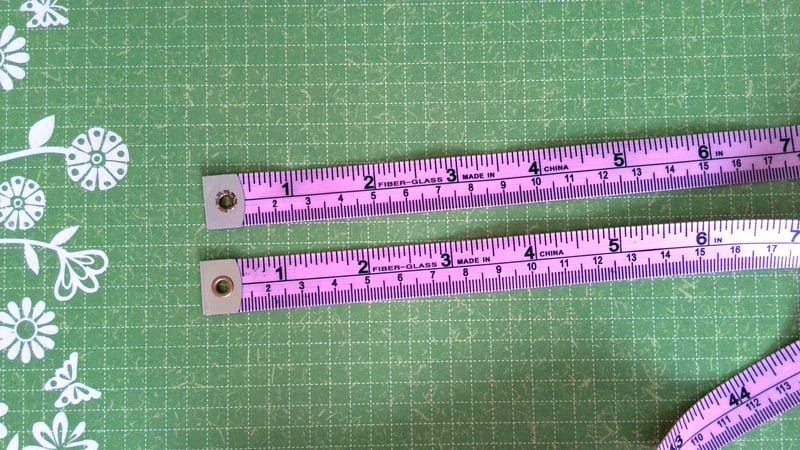
How to read a tape measure in millimeters
The markings on it are applied with the main divisions with an interval of 1 cm and intermediate – ane mm.
A centimeter is divided into ten equal parts – millimeters and one can limited fractions with a decimal point (2.3cm – 2cm 3mm or 23 mm).
How to read a sewing tape measure in inches
The markings on it are applied with the main divisions with an interval of 1 inch and intermediate – ⅛ or 1/xvi in.
An inch is divided into 2, 4, 8, 16 equal parts then the measurement in inches is something like "2 three/8" or "five 3/16". And the decimal point doesn't make real sense for inches.
The epitome below presents a section of tape divided in 1/8" subdivisions, the multiples of ¼" and ½" have longer marks.
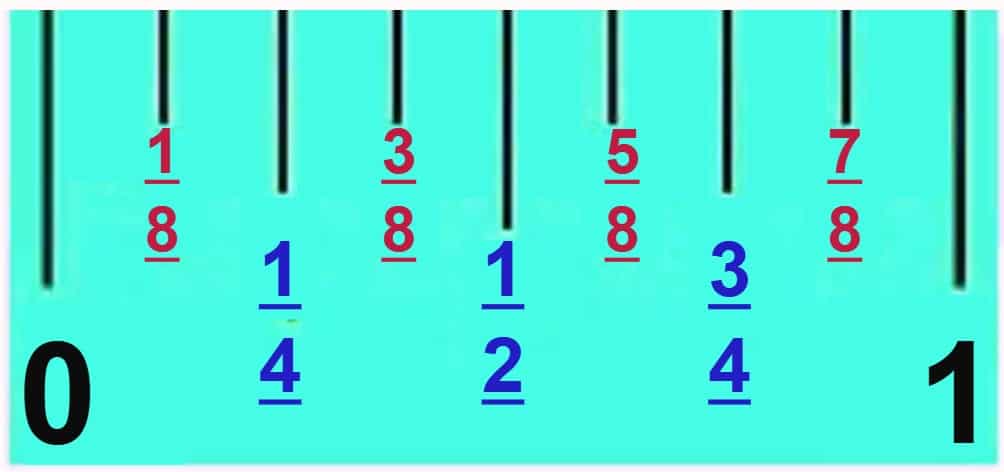
I accept seen measuring tapes (for sewing) with divisions marked for ½, ¼, i/viii and one/16 merely no finer.
The inch fractions are ordinarily marked with a simple line so one would need to count the number of divisions to get the fractions, and I personally always had an effect with this! It is so easy to make a fault! The paradigm below shows a tape with 1/16" divisions, fifty-fifty more than difficult to count. Can y'all pinpoint the 5/xvi on a tape measure immediately? I tin't.
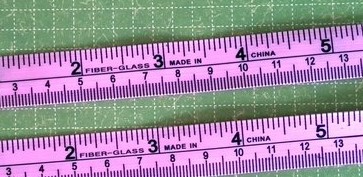
Allow me give you more examples.
How to read a tape measure in 16ths
Permit'southward say my record mensurate has sixteen marks per inch and I employ information technology to measure out a sprint for case. It comes out as 4 whole inches plus 5 piffling marks, then that is 4 and 5/16 inches.
Another instance: permit's use it to measure the altitude betwixt buttonholes (check out my tutorial on making perfect buttonholes) and it comes to 3 whole inches plus ii little marks, then it is three and 2/16 inches. But nosotros will not say that the distance is 3 2/16 inches, we commonly say 2/sixteen every bit ⅛, right? And so our measure for the buttonholes volition exist 3 ⅛ inches.
Another case: allow's say we want to make a hem and it comes out every bit one whole inch plus 4 trivial marks, then that is 1 and iv/xvi inches which we will convert to 1 ¼ inches.
Let's say we have to find out where is ⅝ on a tape measure that has 16 marks per inch. Nosotros convert ⅝ to 16ths – that is x/xvi, right? Then we accept to count 10 little marks on the tape measure – that's how we find ⅝ on the tape measure.

Want to improve your sewing skills?
Get my detailed guide on SEWING MACHINE TENSION ADJUSTMENTS complimentary!
Subscribe to my weekly newsletter with sewing tips and tutorials, free sewing patterns, printable PDFs, and other useful content and you'll observe the eBook in your inbox.
Subscriber sectional offer.
Don't miss the free HELPFUL eBook!
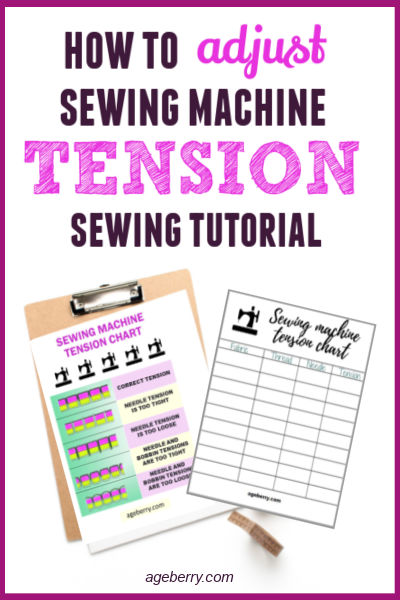
four. How to buy a measuring record for sewing
How to purchase a measuring tape for sewing? This is not difficult, just there are a few details that you must pay attention to.
Everyone who is going to seriously engage in sewing needs to choose a high-quality measuring tape with a guarantee against shrinkage and disappearing marks. The fabric measuring tape must be strong, but flexible, not twisted or stretched and not easily torn.
Pay attention to the material of the tape – it must be strong to serve you every bit long as possible without stretching. Modern professional tapes are made of fiberglass and NEVER stretch. When choosing a tape measure for sewing, remember that it should exist soft and flexible. A rigid measuring tape will not fit on your body or on a design and fabric and all measurements will turn out to be incorrect.
Cull a tape mensurate which scale begins directly from the edge of the tape. If the beginning of the scale is indented from the border, you will need to constantly monitor that this indent doesn't autumn into measurement. In any case, brand sure y'all are measuring from the Zilch LINE.
We too recommend that you select a tape with the scale that starts with a unit 1 at both ends: then no matter what end of the tape you have, the start of the scale will always be in your hands.
Exist certain to check the accuracy of the scale on the tape measure. Accurateness is a basic requirement for any measuring tool. The markings must be bright and clear so you can meet the numbers very well.
A measuring tape scale can exist practical both in inches and centimeters. A double calibration can be useful to you if yous often sew with patterns from magazines or websites of countries where the metric scale is adopted.
The next thing to wait for when buying a measuring tape is the color. Give preference to bright colors – so information technology volition be easier for you to expect for it in the creative mess which usually happens in the sewing room where you cutting fabric and sew. I frequently lose my record on the table among patterns and fabric pieces. What about yous? Only if information technology'southward brilliant pinkish it'due south much easier to meet.
Notation: Some of the links on this page are affiliate links. This means I will receive a commission if y'all society a product through one of my links. I only recommend products I believe in and utilise myself.
If a measuring tape is torn, stretched or rubbed, do not attempt to repair it Because its scale indicators may become inaccurate. This sewing tool is inexpensive, so information technology's amend to immediately buy a new i.
5. Measuring record types
i. Some tapes are marked only in centimeters and millimeters.
2. Some have merely inches and its fractions (in 8ths or 16ths).
3. Some accept both inches and centimeters. Personally I much prefer this type of measuring tapes for sewing. Converting lengths for sewing is simple using a tailor's tape marked in both cm and inch. All you need to do is read the inch side respective to the number in centimeters. If nosotros have to convert for example 66 cm into inches, looking at the paradigm beneath nosotros can see the result is 26 inches.
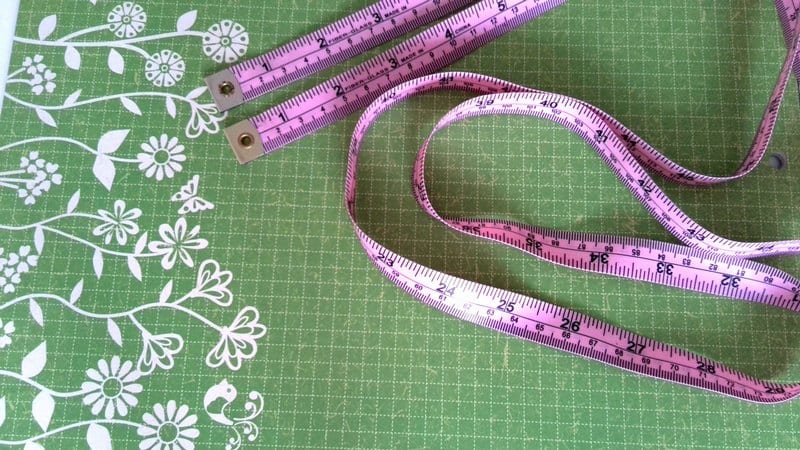
4. 2-sided record mensurate. To me, this is the all-time tape measure because the scale starts with a unit of measurement 1 at both ends: then no thing what finish of the tape y'all have, the beginning of the scale will always exist in your hands. I call back they also called them DUAL SIDED. But in the USA most stores don't accept the two-sided tape (I mean the record with unit 1 on BOTH ends) with in/cm markings on both sides. I bought mine in New York and I found one online. I only tin't use the other blazon that they sell in most material stores. I don't like to lose a lot of time searching for the proper cease to first measuring.
5. Measuring tapes accept unlike lengths and widths.
The most common length is 60″ (152 cm) but longer tapes twice that size exists.
The standard width of a measuring tape is ⅝ inch and this is really helpful considering the standard measurement for seam allowances for most patterns is ⅝ inch. So when I am making simple patterns (like this pattern for shorts for instance, or this design for a unproblematic summit) I am merely using the width of my measuring tape to draw seam allowances in no time flat.
6. The nigh common fabric for such tapes are reinforced polyester and fiberglass which I adopt considering it doesn't stretch. The narrow edges of the record measure are often decorated with metallic rivets that forestall information technology from clothing.
7. Retractable measuring tapes have a self-enclosed case which is a big plus. They can be easily carried in a purse. Choose one that pulls out easily and retracts nicely besides.
nine. Adhesive measuring tapes for sewing.
These removable, adhesive backed measuring tapes are used for marking fabric or sewing tables for quick measurements while cut or trimming. They are printed in Regal and Metric markings. The tape does not adhere well to damp or wet surfaces, so make sure the surface is relatively clean and dry out. I use this along the border of my sewing table for quick measurements.
The measuring tape should exist stored either suspended or rolled up. Information technology'south appropriate to determine a permanent place for it then that yous e'er know where to get information technology.
half dozen. Vintage and antique measuring tapes
There are many sewing tools that take one thousand-twelvemonth- old history. Simply a flexible tape measure is a relatively young invention. Let me tell you some interesting facts about a tailor'southward measuring tape. I am really wondering how they took torso measurements before the invention of a measuring tape? And who was the first to propose using a fabric tape with divisions for taking measurements?
Well, I institute some info that the textile record measure was invented in 1847 by Alexis Lavigne – the master tailor of the French Empress Maria Eugenia, the founder of the globe'south offset fashion school Esmod, which exists to this day.
And since then an elegant, beautifully packed measuring tape turned into a symbol of the profession of a fashion designer and a tailor.
Why measuring tapes were made mainly in a case? I think everything is simple hither. Those vintage measuring tapes were made from cloth, usually silk, and had ink marks (which were printed on them manually) and of grade, the case with some kind of a return mechanism provided some safety.
Below you can see images of some vintage measuring tapes. I found these images online in ane Russian post with trivial historical information.
seven. Tape measure chart PRINTABLE
If you lot desire to easily convert between inches and millimeters employ this chart below with equivalent in mm for inch subdivisions.
The values are rounded to the closest mm value. For example, if the actual value is 7.94 mm nosotros have to round it upwardly to 8 mm because in sewing the millimeter is not divided further – the millimeter is the smallest unremarkably used unit of measurement in the metric system. We tin can't actually run into and use something that's even smaller than a millimeter.
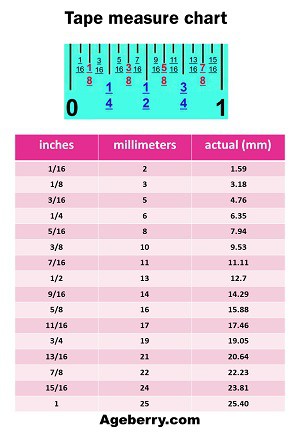
Did you find this tutorial helpful? If and then, relieve this pin (see beneath) on your sewing board so you can come to this tutorial later when you demand to know how to use a tape mensurate and follow me on Pinterest for more tips, tutorials, and inspiration!
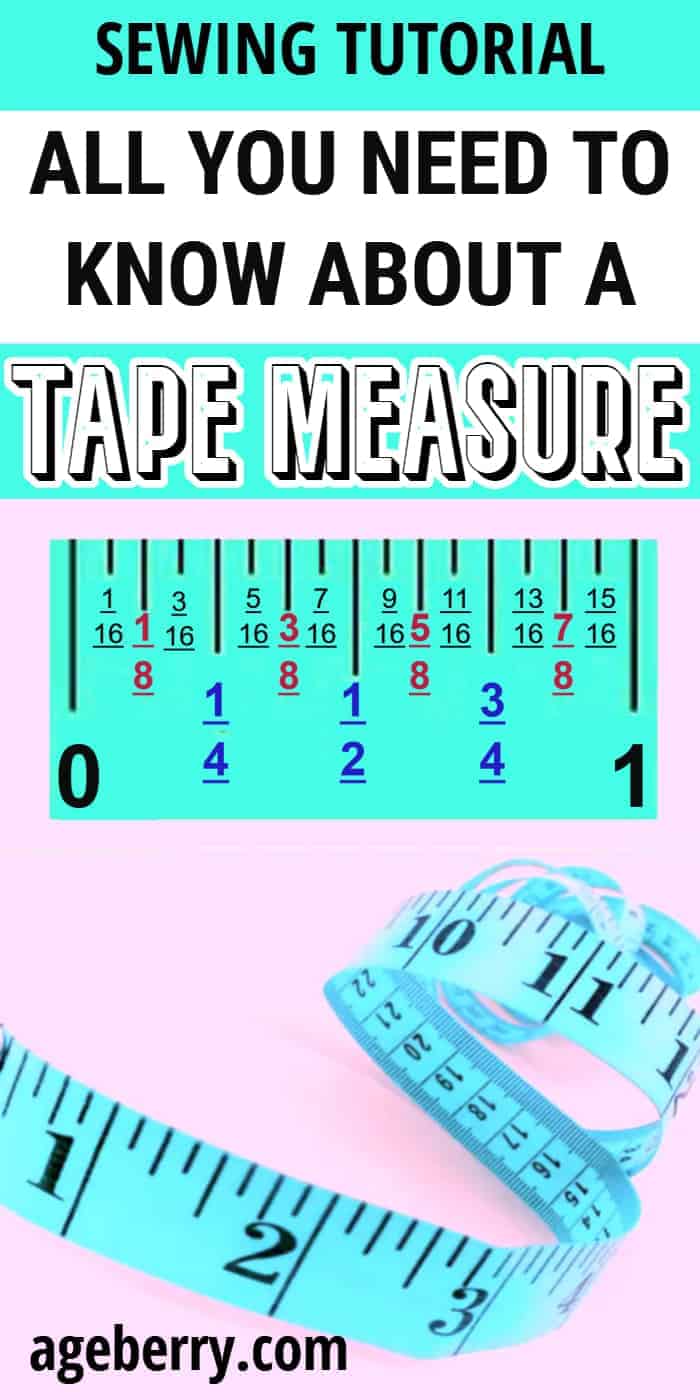
Source: https://www.ageberry.com/tape-measure-for-sewing/
0 Response to "How to Read a Measuring Tape Cm"
Post a Comment